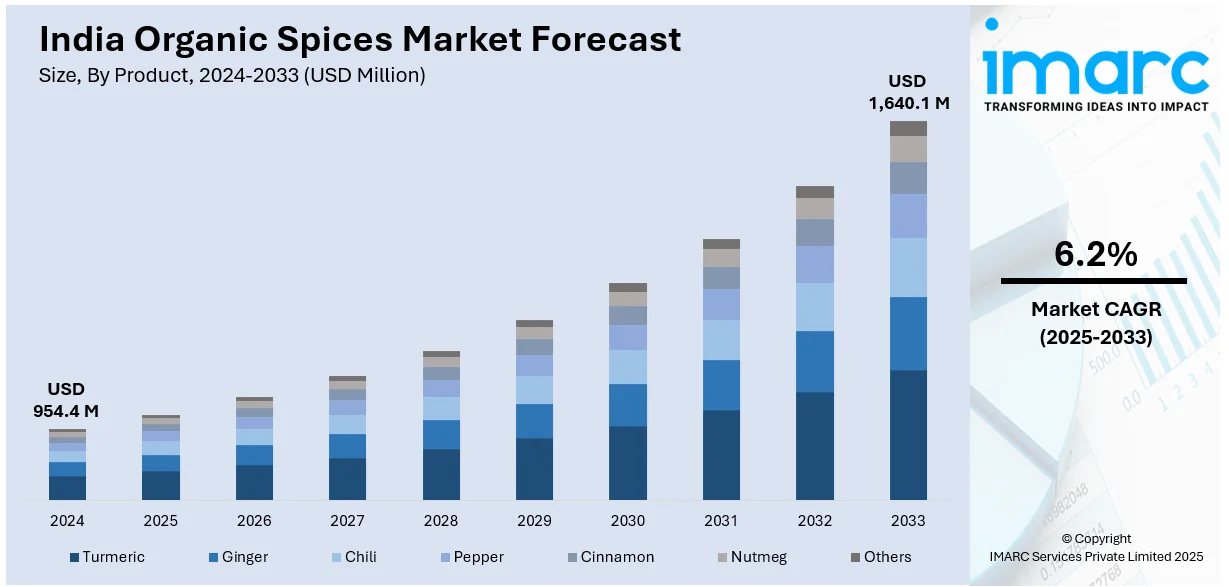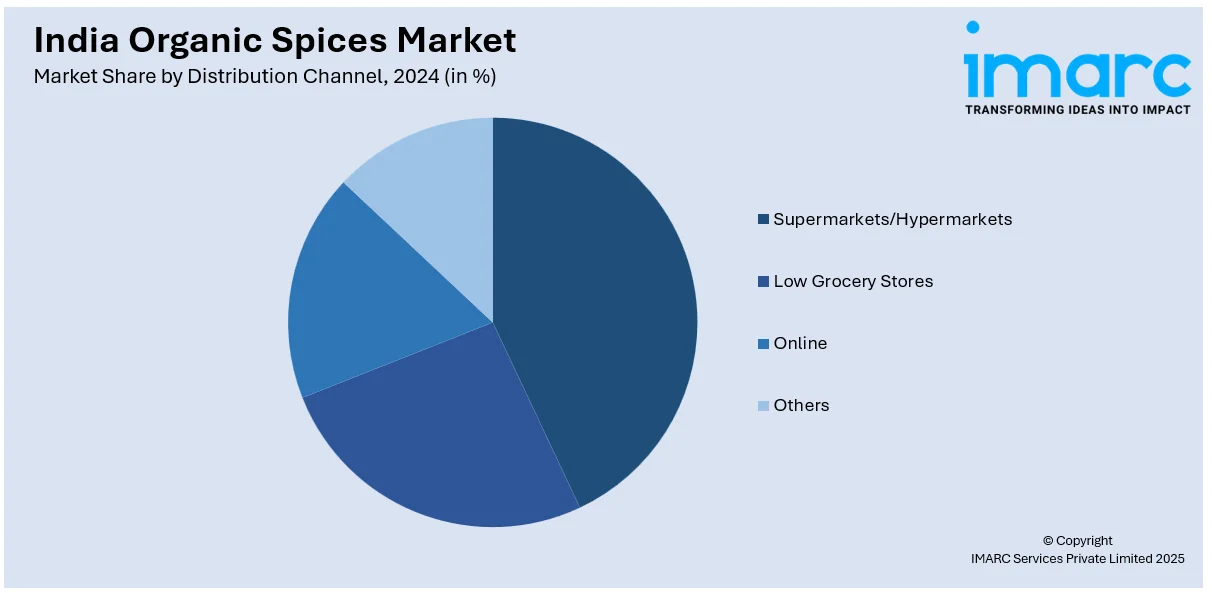
India Organic Spices Market Size, Share, Trends and Forecast by Product, Form, Distribution Channel and Region, 2025-2033
India Organic Spices Market Overview:
The India organic spices market size reached USD 954.4 Million in 2024. Looking forward, IMARC Group expects the market to reach USD 1,640.1 Million by 2033, exhibiting a growth rate (CAGR) of 6.2% during 2025-2033. Rising health consciousness and dietary shifts are driving the demand for organic spices in India, with consumers preferring chemical-free and natural options. Sustainability and ethical sourcing are further strengthening the market growth, as brands are adopting responsible practices.
|
Report Attribute
|
Key Statistics
|
|---|---|
|
Base Year
|
2024 |
|
Forecast Years
|
2025-2033
|
|
Historical Years
|
2019-2024
|
| Market Size in 2024 | USD 954.4 Million |
| Market Forecast in 2033 | USD 1,640.1 Million |
| Market Growth Rate 2025-2033 | 6.2% |
India Organic Spices Market Trends:
Rising Health Consciousness and Dietary Shifts
The growing emphasis on health and wellness is boosting the need for organic spices in India. Consumers are recognizing the connection between their diet and long-term health, resulting in a preference for natural, chemical-free components. Organic spices, devoid of artificial additives and pesticides, resonate with this movement towards mindful eating. The increasing trend of immunity-enhancing diets, detox programs, and anti-inflammatory foods is further supporting this trend. Organic spices are viewed as potent and beneficial, making them a favored option for home cooking and health-oriented meal preparation. Moreover, shifts in diet like veganism and plant-based eating are catalyzing the demand for organic spices, as consumers favor natural flavors and nutrient-rich components. With increasing concerns about food safety, especially related to pesticide residues in conventional spices, more health-conscious consumers are turning to organic alternatives. Leading companies are responding to this demand by introducing certified products to gain consumer trust and drive sales. In 2023, VAHDAM India introduced a selection of organic spices, featuring certified organic varieties like turmeric powder, black pepper powder, cinnamon powder, ginger powder, whole cloves, cumin powder, and onion powder. These spices were obtained from the best organic farms in India and were devoid of pesticides, contaminants, and toxins. The firm highlighted the freshness, cleanliness, and nutritional benefits of these organic spices.

Growing Awareness of Sustainable and Ethical Sourcing
The demand for organic spices in India is being fueled by consumer preference for sustainable practices and responsible sourcing. Individuals are becoming more aware about the social and environmental impact of their food selections, motivating brands to implement sustainable sourcing methods. Organic spice farming enhances biodiversity, improves soil health, and decreases water pollution, supporting environmental sustainability objectives. Concerns about ethical practices related to fair pay and enhanced living standards for farmers bolster market growth, as organic farming typically provides better wages and working environments. Certifications such as Fair Trade and Rainforest Alliance enhance consumer confidence, resulting in increased demand for ethically sourced spices. Food producers and sellers are integrating sustainability assertions into their marketing approaches, addressing consumer demands for responsible supply chains. This change extends beyond premium markets and is also impacting mainstream buying trends, bolstering long-term expansion for the organic spices sector in India. In line with this trend, in 2023, Tulua launched a new line of aromatic spices, including certified organic options like coriander powder, Lakadong turmeric powder, guntur chilli powder, and cumin seed. The brand emphasized quality, sustainability, and ethical sourcing, with plans to make all its spices organic within three months.
India Organic Spices Market Segmentation:
IMARC Group provides an analysis of the key trends in each segment of the market, along with forecasts at the regional level for 2025-2033. Our report has categorized the market based on product, form, and distribution channel.
Product Insights:
- Turmeric
- Ginger
- Chili
- Pepper
- Cinnamon
- Nutmeg
- Others
A detailed breakup and analysis of the market based on the product have also been provided in the report. This includes turmeric, ginger, chili, pepper, cinnamon, nutmeg, and others.
Form Insights:
- Powder
- Whole
- Chopped/Crushed
The report has provided a detailed breakup and analysis of the market based on the form. This includes powder, whole, and chopped/crushed.
Distribution Channel Insights:

- Supermarkets/Hypermarkets
- Low Grocery Stores
- Online
- Others
A detailed breakup and analysis of the market based on the distribution channel have also been provided in the report. This includes supermarkets/hypermarkets, low grocery stores, online, and others.
Regional Insights:
- North India
- South India
- East India
- West India
The report has also provided a comprehensive analysis of all the major regional markets, which include North India, South India, East India, and West India.
Competitive Landscape:
The market research report has also provided a comprehensive analysis of the competitive landscape. Competitive analysis such as market structure, key player positioning, top winning strategies, competitive dashboard, and company evaluation quadrant has been covered in the report. Also, detailed profiles of all major companies have been provided.
India Organic Spices Market News:
- In January 2025, Rapid Organic launched its Organic Cumin Tea (Jaivik Jeera Chai) at the Silver Jubilee Foundation Day celebration of the National Research Centre on Seed Spices in Ajmer, Rajasthan. The tea, made from organic cumin, is promoted for its digestive and detoxifying benefits.
- In May 2024, Amul announced the launch of its high-protein "super milk," containing 35 grams of protein per glass, which was set to hit shelves soon. The company was also introducing organic spices, which were expected to be available in the market in the last week of May.
India Organic Spices Market Report Coverage:
| Report Features | Details |
|---|---|
| Base Year of the Analysis | 2024 |
| Historical Period | 2019-2024 |
| Forecast Period | 2025-2033 |
| Units | Million USD |
| Scope of the Report |
Exploration of Historical Trends and Market Outlook, Industry Catalysts and Challenges, Segment-Wise Historical and Future Market Assessment:
|
| Products Covered | Turmeric, Ginger, Chili, Pepper, Cinnamon, Nutmeg, Others |
| Forms Covered | Powder, Whole, Chopped/ Crushed |
| Distribution Channels Covered | Supermarkets/Hypermarkets, Low Grocery Stores, Online, Others |
| Regions Covered | North India, South India, East India, West India |
| Customization Scope | 10% Free Customization |
| Post-Sale Analyst Support | 10-12 Weeks |
| Delivery Format | PDF and Excel through Email (We can also provide the editable version of the report in PPT/Word format on special request) |
Key Questions Answered in This Report:
- How has the India organic spices market performed so far and how will it perform in the coming years?
- What is the breakup of the India organic spices market on the basis of product?
- What is the breakup of the India organic spices market on the basis of form?
- What is the breakup of the India organic spices market on the basis of distribution channel?
- What is the breakup of the India organic spices market on the basis of region?
- What are the various stages in the value chain of the India organic spices market?
- What are the key driving factors and challenges in the India organic spices market?
- What is the structure of the India organic spices market and who are the key players?
- What is the degree of competition in the India organic spices market?
Key Benefits for Stakeholders:
- IMARC’s industry report offers a comprehensive quantitative analysis of various market segments, historical and current market trends, market forecasts, and dynamics of the India organic spices market from 2019-2033.
- The research report provides the latest information on the market drivers, challenges, and opportunities in the India organic spices market.
- Porter's five forces analysis assist stakeholders in assessing the impact of new entrants, competitive rivalry, supplier power, buyer power, and the threat of substitution. It helps stakeholders to analyze the level of competition within the India organic spices industry and its attractiveness.
- Competitive landscape allows stakeholders to understand their competitive environment and provides an insight into the current positions of key players in the market.
Need more help?
- Speak to our experienced analysts for insights on the current market scenarios.
- Include additional segments and countries to customize the report as per your requirement.
- Gain an unparalleled competitive advantage in your domain by understanding how to utilize the report and positively impacting your operations and revenue.
- For further assistance, please connect with our analysts.
 Inquire Before Buying
Inquire Before Buying
 Speak to an Analyst
Speak to an Analyst
 Request Brochure
Request Brochure
 Request Customization
Request Customization




.webp)




.webp)












